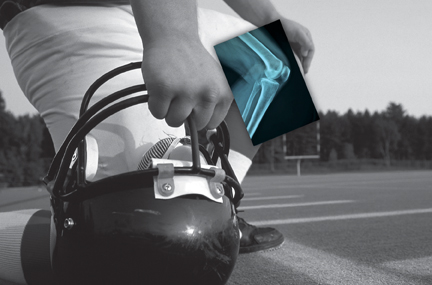
Photo courtesy of Carestream Health
For the most part radiography has been used to help patients. When it comes to football, however, the goal is less to help the athlete and more to get him on the field.
Several years ago the University of Alabama in Birmingham (UAB) cautiously carried a player into the locker room. With his head strapped to the gurney on which he lay, trainers cut off his jersey and shoulder pads, unscrewed the facemask from his helmet, and X-rayed him for what they thought might be a broken neck. When no such injury was found, the player returned to the game, ran a punt back for a touchdown and made a game-saving pick. The UAB director of sports medicine reportedly was so impressed that the university soon installed the NCAA’s first digital X-ray system.
The convoluted logic that led to this outcome is rampant in football today. The National Football League (NFL) has been skewered lately for what amounts to an almost unfathomable lack of sensitivity to personal well-being. The harsh reality of a culture that treats people as objects is apparent in domestic assaults on significant others, as occurred in the case of Ravens’ Ray Rice, and child abuse allegations of the like that haunts the Vikings’ Adrian Peterson.
Football spokespersons would have us think otherwise, but the adoption and use of radiography, particularly in its most advanced form, underscores a culture gone wrong.
At the 2014 NFL Scouting Combine, prospects were evaluated radiographically as part of comprehensive physicals. The exams were described by an administrator at the Indiana University Health Methodist Hospital as “a high volume of chest, orthopedic and other types of X-rays.”
Digital radiography has become all but a necessity in the modern age of football. Several football teams this year jumped into digital radiography, including the Green Bay Packers and San Diego Chargers. They are only the most recent.
Countless arms, legs, hands and feet are imaged during the course of a season, not to mention a good number of shoulders, ribs, necks and heads. These exams may be necessitated by traumatic blows just delivered in practice or games. Or they may be done to assure staff and players that the pins, plates and brackets, inserted due to previous injuries, are where they are supposed to be. Regardless, the quantity is high.
While the optimal dosing possible with digital X-ray may be mentioned when teams acquire a digital radiography system, it is hard to believe that minimizing radiation dose is a big consideration behind the purchase of these systems.
Much more likely it is the efficiency of digital X-ray systems that makes them so attractive, specifically their ability to process exposures into images in seconds and beam those images to monitors, even tablets, in the case of the Packers, in the hands of staff on the sidelines during games.
In short, radiography has become a tool for ruling out injury and getting players onto the football field, not on the road to better health. Their use is another and particularly irritating indication that football is in serious need of culture change.
Greg Freiherr has reported on developments in radiology since 1983. He runs the consulting service, The Freiherr Group. Read more of his views on his blog at www.itnonline.com.


 December 10, 2025
December 10, 2025 









